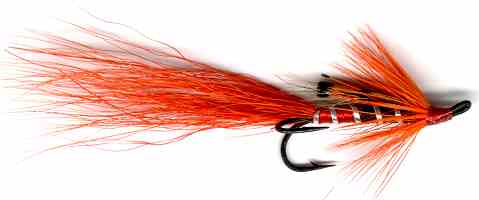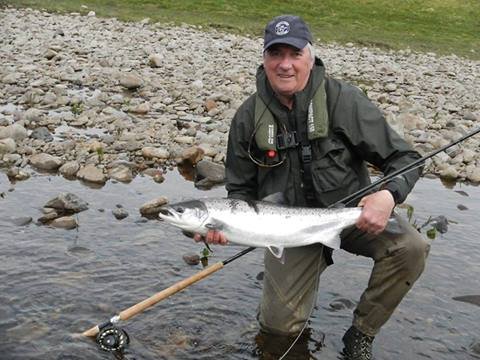Ally's Shrimp Double Hook Salmon Fly
Alistair Gowans created the Allys Shrimp salmon fly pattern to simulate the translucent, shrimp like crustaceans he had observed in trawler catches. This little shrimp is one of the great patterns of all time.

SALMON DOUBLE HOOK FLY PATTERNS. Hook size 4 6 8 10 - $US each
Alistair Gowans created this pattern to simulate the translucent shrimp like crustaceans he had observed in trawler catches. He created it in 1981 and was first publicised in 1988. It is one of the most popular Atlantic Salmon flies. This little shrimp is one of the great patterns of all time. The long flowing tail produces motion that gives the illusion of life. It is a river fly for all seasons. It is very successful for salmon on large rivers. These crustaceans can be found in most rivers, lakes and reservoirs. They form a large part of the trout's menu of edible fast food. Some natural colored shrimps turn orange-brown during the mid summer mating season. A deep fished, artificial shrimp fly pattern can be a killer, especially when it is fished to imitate the shrimp's darting, stop-start, motion. This type of 'sink and draw' is easy to reproduce when you fish with a weighted shrimp on a floating line. Cast the fly and let it sink until you think it is at, or near, the bed of the river or lake. As you retrieve the line the shrimp fly will rise up towards the surface. Stop and the shrimp will dive back down to the bottom. A shrimp fished with six inch pulls followed by two second pauses can be very tantalizing to a trout. If you should fail to get results try longer pulls at greater intervals.

Alistair 'Ally' Gowans is a full time professional flyfishing instructor, author and photographer, he demonstrates fly casting with single and two handed rods in a number of countries and at various fly fishing shows. He has a vast knowledge and experience on the subject of fly fishing for salmon, sea trout and trout from a flyfishing career spanning over 50 years. he is based in Pitlochry, Perthshire in the Highlands of Scotland. He writes articles for a number of different fly fishing magazines. He is an expert Spey caster and instructor. He teaches underhand, roll and overhead Spey casting. He holds many UK fly fishing instructors qualifications but he is also one of the founder holders of the AAPGAI Masters Qualification in both disciplines. He travelled to Seattle and and became the first British instructor to pass all three of the demanding FFF certifications at one event. The Ally's Shrimp was voted 'Salmon Fly of the Millennium' by EMAP readers and came high up in the listings of the 'Worlds best Flies' by NASF
Ally's Shrimp was designed after Alistair went out on a Trawler Fishing boat. He was looking at stocking up his freezer with Lobster but it was the semi translucent shrimps that caught his eye. He had not seen them in the Scottish rivers or along the coast before. He realised that these were the creatures that the Atlantic Salmon feast upon to build up their body weight before they come back to their spawning grounds in the freshwater rivers. He reasoned that if he could design a fly that appeared to look similar to the salmon's favourite deep water food they could be tempted to take a bite when they came across it nearer land. He needed to mimic the naturals dark gut so he used black floss and the for the rear section of the hook shank he used red floss to match the body.
Alistair need to imitate the the shrimps eyes which are half way down the body. He settled on orange Golden Pheasant tippets and place the black ends in the correct location to give the impression that this shrimp fly had black eyes. The orange collar hackle would cocoon the fly as it was fished through the water and produce a shrimp like outline. The Shrimps feelers were imitated by the incorporation of long strands of dyed bucktail hair. When you see shrimp in the supermarket or cooked and on your plate they are curved. The Ally's Shrimp salmon and steelhead fly mimics the shrimp when they are in fast mode trying to swim away from a potential predator. The shrimp thrust out their powerful tails to provide quick forward propulsion as they straighten their body.

VICTORY FROM THE JAWS OF NEAR DEFEAT!
Here is an article about fishing the Ally's Shrimp fly pattern on the River Tweed from Gregor McGregor owner of McGregor Fly Fishing Ltd who makes great fly fishing rods. - A few years ago I was celebrating that tipping point in life when one's age suddenly starts with a '5'! Through that excellent company, Fishpal, a friend of mine had booked two days salmon fishing on the River Tweed at Melrose (Lower Pavilion beat) as a birthday present. This part of the river normally fishes well in the summer, but that summer was devoid of water and very hot! Access to the beat is easy – just park up and a short walk along the riverside toward the meeting point. When I met the ghillie at 9.00 on a torrid, bright morning I knew the prospects were not great, but was taken aback when he used a resounding negative expletive to describe them! This is something a ghillie never does! At worst he may say, 'We may struggle a little today, sir, but I think we're in with a chance!'. I was crestfallen by his forecast!
Nevertheless, I tackled up, using a new Hardy's 'Angel' 15'0'' LW10 rod which my company had just presented to me with my name inscribed on it as a gift. I was working for Hardy's at the time as a marketing consultant and was, of course, thrilled by the thoughtfulness of both my company and Hardy's! I coupled this with a Hardy Mach 55 Spey line, and on the tippet tied a size 8 double Ally's Shrimp, one of my all-time favourite flies, so successful in many varied conditions. The conditions I was faced with were extreme, to say the least! The mighty Tweed, Europe's most prolific salmon river, resembled more a series of ponds linked by a small stream! Undaunted, the ghillie and I went to one of the deeper 'ponds' and I started rolling out a Spey cast as gently as I could, so as not to spook any fish that might - just perhaps - be lurking there.
I so enjoy Spey casting, with its smooth elegance when well executed, that I can enjoy a day on the river, even if I know the fish have shot upstream and my chances of contact are very slim. I compare it to developing a good golf swing! After a short while the ghillie had to see to another client and left me with my forlorn hope of seeing any action. The water was far from gin-clear, so I fished the fly deep using a sinking leader. After half an hour I thought I had fished it too deep and snagged the bottom. I tugged hard, bending the 'Angel' into a steep arc, and moving up and down the bank, but to no avail. Suddenly, the 'bottom' showed signs of movement! I could hardly believe it! 'Fish on!', I whispered to myself! But I was alone, and the ghillie had the net! I battled on for forty five minutes with a behemoth glued by means of vacuum to the riverbed, praying for the ghillie to return.
The fish was clearly large and hugged the bottom, moving around sluggishly among underwater obstacles and fouling up the line with large amounts of weed which the conditions had brought on. My 20-lbs tippet was being tested to the limit. As I felt it being dragged over rocks I feared the worst. But I kept the pressure up and slowly started to gain line. My spirits suddenly soared as I saw the ghillie returning, with net and useful tips about the topography of the river bottom. As we glimpsed the first flashes of bright silver, he said, 'That's one hell of a fush, sir!' We worked the fish into a spot good for landing, I 'backed up' a few yards to keep a decent length of line between me and the fish to act as a shock absorber, should it make one last dash for freedom, and the ghillie deftly tailed it! A beautiful fresh-run hen, it weighed in at 25 lbs, easily my personal best, and given the conditions, an outstanding fish.
So now, trophy picture opportunity and time to get the fish back in the water! Ah! Neither of us had a camera! The ghillie had said he would bring his, so I need not bother! But he'd left it in the hut. On the basis of testimonial from a trusted and well-known ghillie, the fish entered the annals of the River Tweed Catch Returns, but I had no photograph of my fish of a lifetime! Nevertheless, the image of that 'bar of silver' is firmly lodged in my brain forever!' - Gregor McGregor

